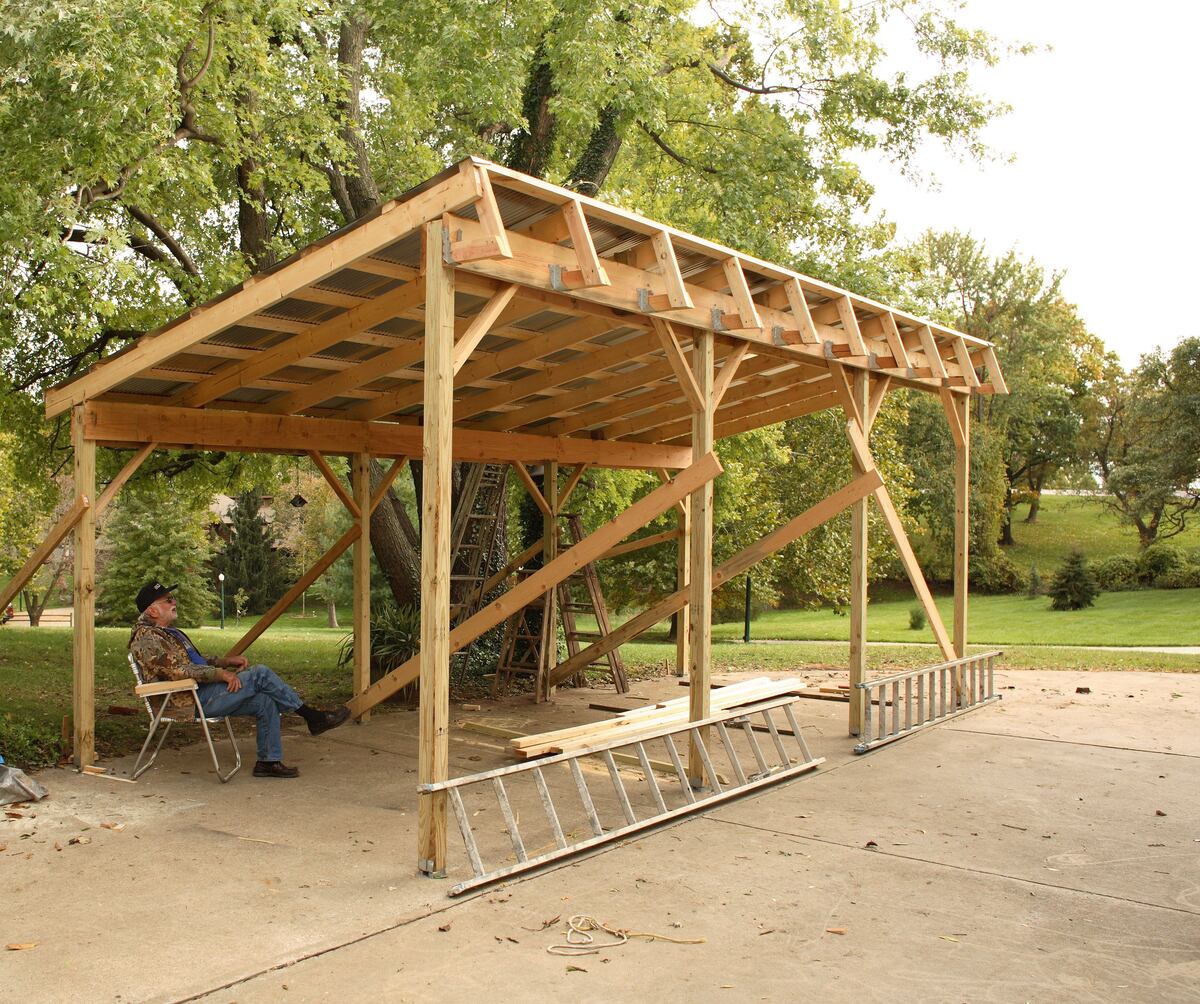Home>Articles>How Big Can A Porch Be Without Planning Permission


Articles
How Big Can A Porch Be Without Planning Permission
Modified: October 19, 2024
Learn about the size limitations of porches without needing planning permission in this informative article. Discover all you need to know about porch dimensions for a hassle-free construction process.
(Many of the links in this article redirect to a specific reviewed product. Your purchase of these products through affiliate links helps to generate commission for Storables.com, at no extra cost. Learn more)
Introduction
Welcome to our comprehensive guide on the topic of “How Big Can a Porch Be Without Planning Permission?” If you’re considering adding a porch to your home, you may be wondering about the regulations and restrictions surrounding its size. Planning permission is a crucial aspect of any home improvement project, and understanding what is allowed without going through the planning process can save you time, money, and hassle.
In this article, we will provide you with a detailed explanation of the rules and regulations regarding porch size and planning permission. We’ll explore the concept of permitted development rights, discuss the maximum dimensions allowed for porches, and highlight the key factors you need to consider when planning the size of your porch.
Before we dive into the specifics, let’s have a brief overview of what planning permission is and why it is important. Planning permission is the formal consent required from the local planning authority before carrying out any significant changes to a property. It ensures that the proposed development is suitable for its surroundings, adheres to zoning regulations, and meets other legal requirements.
However, certain minor alterations fall under permitted development rights, which means they can be carried out without obtaining planning permission. These rights grant homeowners some flexibility in making changes to their properties as long as they meet specific criteria.
When it comes to porches, there are specific guidelines regarding their size that determine whether planning permission is required. These guidelines aim to balance the homeowner’s desire to enhance their property with maintaining the overall aesthetics and character of the area. Understanding these guidelines is crucial to avoid any complications or legal issues during the construction of your porch.
In the next section, we will delve into the details of permitted development rights and how they pertain to porches. So, let’s proceed and explore the realm of porch regulations!
Key Takeaways:
- Understanding the specific criteria and conditions set by your local planning authority is crucial when considering the size and design of a porch. Adhering to permitted development rights can save time and money.
- When planning a porch, consider factors such as property size, functionality, and neighborly impact. A well-designed porch that complies with regulations and enhances the property’s aesthetics can be achieved with careful consideration and professional guidance.
Understanding Planning Permission for Porches
Before embarking on any home improvement project, including adding a porch, it’s important to understand the concept of planning permission. Planning permission is the formal consent required from the local planning authority to carry out certain types of developments or alterations to a property. It ensures that changes to the property are in line with the local planning policies, zoning regulations, and the overall aesthetic and character of the area.
When it comes to porches, there are specific guidelines regarding planning permission. In many cases, porches can fall under the category of permitted development rights, which means they can be constructed without obtaining formal planning permission. However, there are certain restrictions and criteria that must be met to qualify for these rights.
Permitted development rights for porches usually depend on various factors, including the size of the porch, its location, and the overall impact it has on the property and neighborhood. These factors are assessed to ensure that the porch does not negatively affect neighboring properties, obscure sightlines, or disrupt the overall aesthetic of the street.
It’s important to note that planning permission is not always required for small porch additions. Local authorities often have specific criteria for porch sizes that do not require planning permission. These criteria are put in place to streamline the construction process for homeowners and avoid unnecessary bureaucracy.
Before proceeding with the construction of a porch, it is recommended to consult with your local planning authority or review their online guidance to understand the specific requirements for porches in your area. This will help you determine whether planning permission is needed and ensure that your porch complies with local regulations.
In the next section, we will explore the maximum dimensions allowed for porches without planning permission. Understanding these dimensions is crucial to determine the size and scope of your porch project. So, let’s dive into the details!
Permitted Development Rights for Porches
Permitted development rights allow homeowners to make certain improvements to their properties without the need for formal planning permission. These rights provide a streamlined process for minor alterations, including the construction of porches, as long as they meet specific criteria set by the local planning authority.
When it comes to porches, permitted development rights typically apply if certain conditions are met. These conditions may include the size, location, and impact of the porch on the property and surrounding area. It is important to note that these conditions can vary depending on the local authority, so it is always recommended to check with your specific planning department.
Typically, for porches to fall within permitted development rights, they must meet the following criteria:
- The porch is located at ground level and has a separate external entrance.
- It does not exceed a certain size, both in terms of its footprint and height.
- It is not on an elevated platform or raised platform.
- It does not have a floor area over a specified limit.
- It does not project beyond the principal elevation of the property that faces a road or public space.
These criteria are put in place to ensure that the porch is of a reasonable size, does not obstruct the view or privacy of neighboring properties, and maintains the overall aesthetic of the area.
It is important to note that even if your porch meets the permitted development criteria, it is still subject to other regulations and restrictions, such as building regulations and adherence to any local covenants or restrictions. These regulations ensure that the construction is safe and complies with other legal requirements.
While permitted development rights provide a simplified process for porch construction, it is always advisable to consult with your local planning department or seek the advice of a professional architect or builder. They can guide you through the specific requirements and help ensure that your porch project is compliant with all pertinent regulations.
In the next section, we will explore the maximum dimensions allowed for porches without planning permission. Understanding these dimensions is essential for determining the size and scope of your porch project while staying within the boundaries of permitted development. Let’s dive into the details!
Maximum Dimensions for Porches without Planning Permission
When constructing a porch without the need for planning permission, it is important to understand the maximum dimensions allowed. These dimensions are typically put in place to ensure that the porch remains a minor alteration and does not have a significant impact on the property or the surrounding area.
The maximum dimensions for porches without planning permission can vary depending on local regulations. However, there are some general guidelines that you can consider. These guidelines usually include the following:
- The porch must have a maximum height of 3 meters.
- The area of land covered by the porch, when combined with any other buildings or structures, must not exceed 50% of the total area of land around the original house.
- The porch must not extend forward of the principal elevation or side elevation fronting a highway.
- The porch must not have a width greater than 3 meters.
- For terraced or semi-detached houses, the porch must not exceed 3 square meters in floor area.
It is important to note that these dimensions are general guidelines and may vary depending on the specific regulations and requirements set by your local planning authority. Some areas may have stricter or more relaxed limits on porch dimensions, so it is always advisable to consult with your local planning department to ensure compliance.
Additionally, it is important to consider other factors beyond the maximum dimensions when planning your porch. These factors may include the design and materials used, the impact on neighboring properties, and any potential restrictions imposed by homeowners’ associations or other local governing bodies.
If your proposed porch exceeds the permitted development size limits or does not meet other criteria, you may still be able to obtain planning permission. In such cases, it is recommended to engage the services of an architect or planning consultant who can help you navigate the planning process and maximize the chances of approval.
Now that you have a better understanding of the maximum dimensions allowed for porches without planning permission, it’s time to consider the various factors that should be taken into account when determining the size of your porch. The next section will delve into these factors and provide valuable insights to help you make informed decisions. Let’s explore!
Factors to Consider Regarding Porch Size
When determining the size of your porch, there are several important factors to consider. These factors will help you strike a balance between the desired size of your porch and compliance with planning regulations, as well as ensuring that your porch complements your property and enhances its overall functionality. Let’s explore some of these essential factors:
Read more: How Big Can A Pergola Be Without A Permit?
1. Property Size and Proportions
The size and proportions of your property will play a significant role in determining an appropriate porch size. A porch that is too small may appear insignificant or out of proportion, while a porch that is too large can overpower the property’s design. Consider the scale and style of your home to ensure that the porch harmonizes with its aesthetic appeal.
2. Functionality and Purpose
Consider the intended purpose of your porch. Will it be primarily used as an entryway, a sitting area, or a space to showcase potted plants? The intended function of the porch will dictate its size and layout. Ensure that there is enough space to comfortably accommodate the activities or furniture arrangements you have in mind.
3. Access and Circulation
Take into account the flow and circulation patterns within and around your property. Design your porch in a way that allows for easy access to your home and does not obstruct pathways or walkways. Consider how the porch will connect with existing entry points and ensure that it facilitates smooth movement between indoor and outdoor spaces.
4. Neighborly Considerations
Respect the privacy and visual impact on neighboring properties. Avoid a porch size that may obstruct or overlook their properties, as this could lead to potential objections and complications. Maintaining good neighborly relationships is essential, so be mindful of how your porch may affect those around you.
5. Local Planning Regulations
Always refer to the specific planning regulations in your area to understand the limitations and requirements for porch size. Ensure that your porch aligns with these regulations to avoid potential fines or legal issues in the future.
By carefully considering these factors, you can ensure that your porch size not only meets your needs but also complies with planning requirements and enhances the overall aesthetics and functionality of your property.
Next, we will delve into some exceptions and special cases where planning permission may be required for porches, even if they fall within the permitted development limits. Understanding these exceptions is essential for a successful porch construction project. Let’s explore!
Exceptions and Special Cases
While many porch constructions may fall under permitted development rights, there are certain exceptions and special cases where planning permission may still be required. It’s important to be aware of these exceptions to ensure compliance with the regulations set by your local planning authority. Let’s explore some of these exceptions:
Conservation Areas
If your property is located within a conservation area, additional restrictions may apply. These areas are designated for their architectural or historic interest, and any alterations, including porches, may require planning permission to ensure preservation of the area’s character and heritage.
Listed Buildings
If your property is a listed building, which is a building of special architectural or historic interest, any alterations, including porches, are subject to strict regulations. Planning permission is almost always required for any changes to listed buildings, regardless of size.
Read more: How Big Should Porch Columns Be
Article 4 Direction
In some cases, local authorities may issue an Article 4 Direction, which restricts certain types of development that would otherwise fall within permitted development rights. If an Article 4 Direction is in place for your area, you may need to obtain planning permission for porch construction, regardless of size.
Flats and Maisonettes
If you live in a flat or maisonette, the rules for porch construction may differ. In some cases, you may need to obtain planning permission even for small porch additions due to stricter regulations regarding communal spaces or the impact on the visual appearance of the building.
Change of Use
If your porch is intended for a change of use, such as converting it into an additional habitable space, it may require planning permission. Changing the use of a porch can have implications for the overall functionality and impact on the property, warranting a closer review by the planning authority.
It’s important to check with your local planning department to determine if any of these exceptions apply to your property. Consulting with planning professionals or architects can also provide valuable insight and guidance in navigating these special cases.
Now that we’ve covered the exceptions and special cases to be aware of, let’s move on to understanding the relationship between planning permission and porch design in the next section.
Planning Permission and Porch Design
When it comes to porch design, it’s important to understand the relationship between planning permission and the overall aesthetics of your porch. While planning permission primarily focuses on the size and impact of the porch, it is also important to ensure that the design of your porch aligns with the architectural style of your home and the character of the surrounding area.
When designing your porch, consider the following aspects:
Read more: How Big Are Outdoor Trash Cans
1. Material and Finish
Choose materials and finishes that harmonize with the existing structure of your home. Whether it’s brick, timber, stone, or uPVC, selecting materials that complement the architectural style of your property will enhance the overall visual appeal of the porch.
2. Roof Design
The design of the porch roof should be in line with the roof design of the main house. Whether it’s a flat roof, gable roof, hipped roof, or a combination, ensure that the roof design of the porch seamlessly integrates with the overall roofline of your home.
3. Windows and Doors
Consider the style and design of the windows and doors for your porch. Whether it’s traditional, modern, or a custom design, make sure they complement the existing windows and doors of your home, creating a cohesive and unified look.
4. Proportions and Scale
Pay attention to the proportions and scale of your porch. It should not overwhelm the main structure of your home or dominate the facade. A well-designed porch should blend seamlessly with the overall look and feel of the property, enhancing its curb appeal.
Read more: How Big Is A Normal Trash Can
5. Lighting and Accessories
Think about incorporating appropriate lighting fixtures and accessories that enhance the functionality and aesthetics of your porch. This could include wall lanterns, recessed lighting, or decorative elements that add charm and character to the space.
6. Landscaping and Surroundings
Consider how your porch design interacts with the surrounding landscape. Incorporate landscaping elements that complement the porch and create a visually pleasing environment. This could include adding plants, shrubs, or even a pathway leading up to the porch entrance.
By paying attention to these design aspects, you can create a porch that not only meets planning regulations but also seamlessly integrates with the architectural style of your home and enhances its overall visual appeal.
Remember, even if your porch falls within the permitted development limits and adheres to the design guidelines, it is always advisable to consult with your local planning department or seek professional advice to ensure compliance with all relevant regulations.
Now that you have a better understanding of the relationship between planning permission and porch design, let’s wrap up our comprehensive guide on how big a porch can be without planning permission.
Conclusion
In conclusion, understanding the regulations and guidelines around porch construction without the need for planning permission is essential for homeowners considering this type of home improvement. By adhering to the permitted development rights and maximum dimensions, you can avoid the lengthy and often costly process of obtaining planning permission.
Start by familiarizing yourself with the specific criteria and conditions set by your local planning authority. This includes understanding the size limits, height restrictions, and location considerations for porches. Additionally, be aware of any exceptions or special cases that may require planning permission, such as living in a conservation area or a listed building.
When planning the size of your porch, take into account factors such as the property’s size and proportions, functionality, access, and neighborly considerations. Striking a balance between a porch that meets your needs and complies with regulations is crucial.
Furthermore, consider the design aspect of your porch in terms of materials, roof design, windows and doors, proportions, lighting, and the overall integration with the property and its surroundings. A well-designed porch will enhance the aesthetics and character of your home.
Throughout the process, it is recommended to consult with your local planning department or seek professional advice to ensure compliance and avoid any legal issues. They can provide valuable insights and guidance specific to your location and circumstances.
In summary, with a good understanding of the regulations, thoughtful planning, and adherence to guidelines, you can successfully construct a porch that enhances your home’s aesthetics, functionality, and value without the need for planning permission. So go ahead and explore the possibilities of adding a beautiful porch to your property!
Frequently Asked Questions about How Big Can A Porch Be Without Planning Permission
Was this page helpful?
At Storables.com, we guarantee accurate and reliable information. Our content, validated by Expert Board Contributors, is crafted following stringent Editorial Policies. We're committed to providing you with well-researched, expert-backed insights for all your informational needs.











0 thoughts on “How Big Can A Porch Be Without Planning Permission”